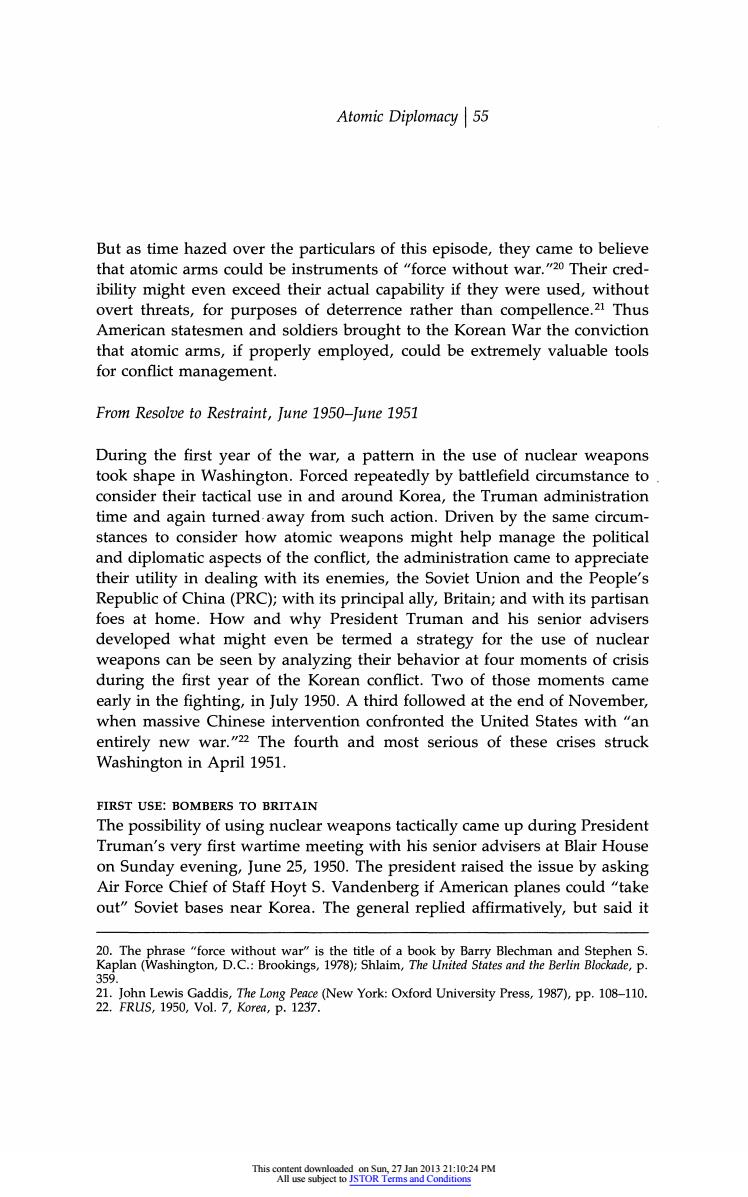正在加载图片...

Atomic Diplomacy 55 But as time hazed over the particulars of this episode,they came to believe that atomic arms could be instruments of "force without war."20 Their cred- ibility might even exceed their actual capability if they were used,without overt threats,for purposes of deterrence rather than compellence.21 Thus American statesmen and soldiers brought to the Korean War the conviction that atomic arms,if properly employed,could be extremely valuable tools for conflict management. From Resolve to Restraint,June 1950-June 1951 During the first year of the war,a pattern in the use of nuclear weapons took shape in Washington.Forced repeatedly by battlefield circumstance to consider their tactical use in and around Korea,the Truman administration time and again turned away from such action.Driven by the same circum- stances to consider how atomic weapons might help manage the political and diplomatic aspects of the conflict,the administration came to appreciate their utility in dealing with its enemies,the Soviet Union and the People's Republic of China(PRC);with its principal ally,Britain;and with its partisan foes at home.How and why President Truman and his senior advisers developed what might even be termed a strategy for the use of nuclear weapons can be seen by analyzing their behavior at four moments of crisis during the first year of the Korean conflict.Two of those moments came early in the fighting,in July 1950.A third followed at the end of November, when massive Chinese intervention confronted the United States with "an entirely new war."22 The fourth and most serious of these crises struck Washington in April 1951. FIRST USE:BOMBERS TO BRITAIN The possibility of using nuclear weapons tactically came up during President Truman's very first wartime meeting with his senior advisers at Blair House on Sunday evening,June 25,1950.The president raised the issue by asking Air Force Chief of Staff Hoyt S.Vandenberg if American planes could "take out"Soviet bases near Korea.The general replied affirmatively,but said it 20.The phrase"force without war"is the title of a book by Barry Blechman and Stephen S. Kaplan (Washington,D.C.:Brookings,1978);Shlaim,The United States and the Berlin Blockade,p. 359. 21.John Lewis Gaddis,The Long Peace (New York:Oxford University Press,1987),pp.108-110. 22.FRUS,1950,Vol.7,Korea,p.1237. This content downloaded on Sun,27 Jan 2013 21:10:24 PM All use subject to JSTOR Terms and ConditionsAtomic Diplomacy |55 But as time hazed over the particulars of this episode, they came to believe that atomic arms could be instruments of "force without war."20 Their credibility might even exceed their actual capability if they were used, without overt threats, for purposes of deterrence rather than compellence.21 Thus American statesmen and soldiers brought to the Korean War the conviction that atomic arms, if properly employed, could be extremely valuable tools for conflict management. From Resolve to Restraint, June 1950-June 1951 During the first year of the war, a pattern in the use of nuclear weapons took shape in Washington. Forced repeatedly by battlefield circumstance to consider their tactical use in and around Korea, the Truman administration time and again turned away from such action. Driven by the same circumstances to consider how atomic weapons might help manage the political and diplomatic aspects of the conflict, the administration came to appreciate their utility in dealing with its enemies, the Soviet Union and the People's Republic of China (PRC); with its principal ally, Britain; and with its partisan foes at home. How and why President Truman and his senior advisers developed what might even be termed a strategy for the use of nuclear weapons can be seen by analyzing their behavior at four moments of crisis during the first year of the Korean conflict. Two of those moments came early in the fighting, in July 1950. A third followed at the end of November, when massive Chinese intervention confronted the United States with "an entirely new war."22 The fourth and most serious of these crises struck Washington in April 1951. FIRST USE: BOMBERS TO BRITAIN The possibility of using nuclear weapons tactically came up during President Truman's very first wartime meeting with his senior advisers at Blair House on Sunday evening, June 25, 1950. The president raised the issue by asking Air Force Chief of Staff Hoyt S. Vandenberg if American planes could "take out" Soviet bases near Korea. The general replied affirmatively, but said it 20. The phrase "force without war" is the title of a book by Barry Blechman and Stephen S. Kaplan (Washington, D.C.: Brookings, 1978); Shlaim, The United States and the Berlin Blockade, p. 359. 21. John Lewis Gaddis, The Long Peace (New York: Oxford University Press, 1987), pp. 108-110. 22. FRUS, 1950, Vol. 7, Korea, p. 1237. This content downloaded on Sun, 27 Jan 2013 21:10:24 PM All use subject to JSTOR Terms and Conditions